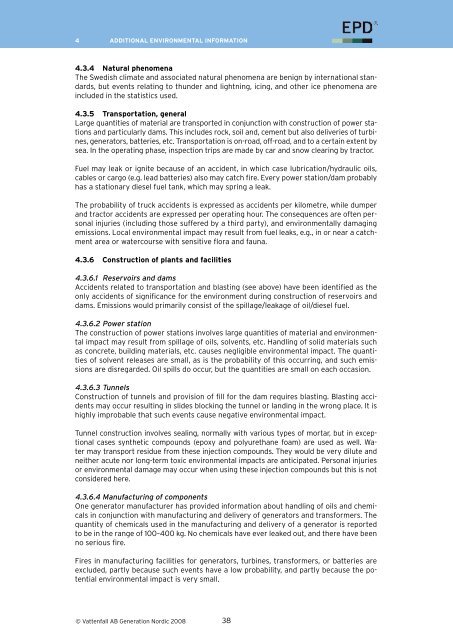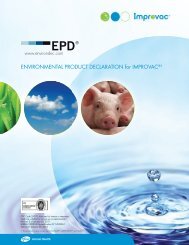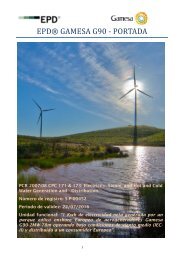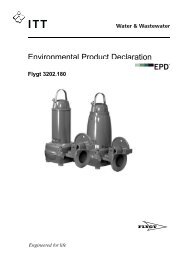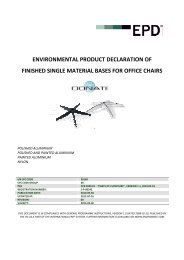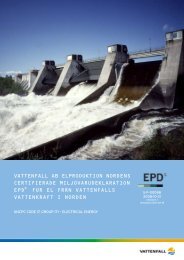Vattenfall aB GeneRatIOn nORDIC CeRtIfIeD enVIROnmental ...
Vattenfall aB GeneRatIOn nORDIC CeRtIfIeD enVIROnmental ...
Vattenfall aB GeneRatIOn nORDIC CeRtIfIeD enVIROnmental ...
Create successful ePaper yourself
Turn your PDF publications into a flip-book with our unique Google optimized e-Paper software.
4 Additional environmental information<br />
4.3.4 Natural phenomena<br />
The Swedish climate and associated natural phenomena are benign by international standards,<br />
but events relating to thunder and lightning, icing, and other ice phenomena are<br />
included in the statistics used.<br />
4.3.5 Transportation, general<br />
Large quantities of material are transported in conjunction with construction of power stations<br />
and particularly dams. This includes rock, soil and, cement but also deliveries of turbines,<br />
generators, batteries, etc. Transportation is on-road, off-road, and to a certain extent by<br />
sea. In the operating phase, inspection trips are made by car and snow clearing by tractor.<br />
Fuel may leak or ignite because of an accident, in which case lubrication/hydraulic oils,<br />
cables or cargo (e.g. lead batteries) also may catch fire. Every power station/dam probably<br />
has a stationary diesel fuel tank, which may spring a leak.<br />
The probability of truck accidents is expressed as accidents per kilometre, while dumper<br />
and tractor accidents are expressed per operating hour. The consequences are often personal<br />
injuries (including those suffered by a third party), and environmentally damaging<br />
emissions. Local environmental impact may result from fuel leaks, e.g., in or near a catchment<br />
area or watercourse with sensitive flora and fauna.<br />
4.3.6 Construction of plants and facilities<br />
4.3.6.1 Reservoirs and dams<br />
Accidents related to transportation and blasting (see above) have been identified as the<br />
only accidents of significance for the environment during construction of reservoirs and<br />
dams. Emissions would primarily consist of the spillage/leakage of oil/diesel fuel.<br />
4.3.6.2 Power station<br />
The construction of power stations involves large quantities of material and environmental<br />
impact may result from spillage of oils, solvents, etc. Handling of solid materials such<br />
as concrete, building materials, etc. causes negligible environmental impact. The quantities<br />
of solvent releases are small, as is the probability of this occurring, and such emissions<br />
are disregarded. Oil spills do occur, but the quantities are small on each occasion.<br />
4.3.6.3 Tunnels<br />
Construction of tunnels and provision of fill for the dam requires blasting. Blasting accidents<br />
may occur resulting in slides blocking the tunnel or landing in the wrong place. It is<br />
highly improbable that such events cause negative environmental impact.<br />
Tunnel construction involves sealing, normally with various types of mortar, but in exceptional<br />
cases synthetic compounds (epoxy and polyurethane foam) are used as well. Water<br />
may transport residue from these injection compounds. They would be very dilute and<br />
neither acute nor long-term toxic environmental impacts are anticipated. Personal injuries<br />
or environmental damage may occur when using these injection compounds but this is not<br />
considered here.<br />
4.3.6.4 Manufacturing of components<br />
One generator manufacturer has provided information about handling of oils and chemicals<br />
in conjunction with manufacturing and delivery of generators and transformers. The<br />
quantity of chemicals used in the manufacturing and delivery of a generator is reported<br />
to be in the range of 100–400 kg. No chemicals have ever leaked out, and there have been<br />
no serious fire.<br />
Fires in manufacturing facilities for generators, turbines, transformers, or batteries are<br />
excluded, partly because such events have a low probability, and partly because the potential<br />
environmental impact is very small.<br />
© <strong>Vattenfall</strong> AB Generation Nordic 2008 38


